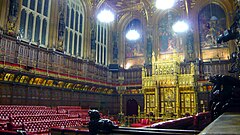Assembly of Commons
Assembly of Commons Assemblye uft Commys | |
|---|---|
 Coat of arms | |
 Flag | |
| Type | |
| Type | |
Term limits | 2 |
| History | |
| Founded | 1815 by the Parliament Representation Act 1815; 209 years ago |
| Leadership | |
The Minister Hurmes von Lytsyn since 1 July 2022 | |
The Minister Galitsyn Vonhoutsyn since 1 July 2022 | |
PM Saiah Dunwille since 1 July 2022 | |
The Whip Fammawyth Nythera since 14 August 2023 | |
The Whip Nymeth Ferk since 6 February 2023 | |
Sycor Ricoratsyn since 1 July 2022 | |
| Structure | |
| Seats | 188 |
 | |
Political groups | Government (104)
Opposition (77) Crossbenchers (7)
Speaker (1)
|
Length of term | 6 years; renewable twice inclusive |
| Elections | |
Last election | 15 June 2022 |
Next election | 15 June 2028 |
| Meeting place | |
 | |
| Horessen Palace, Constitution Square, Lomercoyne NK-LC, Chatten and Leucen | |
| Website | |
| www.assembly.gov.chl | |
| Constitution | |
| Constitution of Chatten and Leucen (1945) | |
The Assembly of Commons (Leucish: Assemblye uft Commys) is the lower house of the Chalcish Parliament, the bicameral legislature of Chatten and Leucen. It is composed of 188 members, which is divided into 25 sections representing each state and the federal district. The approportionment of the members are based on the Colby method. As the lower house of the Chalcish Parliament, it represents the people of Chatten and Leucen and one of the chambers that is directly elected by the people. Each state is given a specific number of seats per election cycle; the number of seats can change depending on that states' population. Currently, the number of seats in the House of Commons is 188.
The Assembly of Commons was established by the Parliament Representation Act 1815 of the Parliament and was ratified by Nethania III & I herself, turning the Chalcish Parliament into a bicameral legislature. Between 1815 and 1830, the Assembly of Commons doubled in size from its initial seats of 200 up to 420 by the new Constituency System. After the signing of the Enabling Act of 1830, the House of Commons adopted the Colby Method into determining the number of seats each newly formed crown state could have. Though initial support for adopting the system used by the House of Baronies was great for the first decade of the Assembly of Commons, the idea was later disposed off in favor of the Colby Method. The Prime Minister derives its legitimacy from both the Assembly and the House. The Assembly is headed by the Assembly Speaker, with the Assembly Leader being their second-in-command.